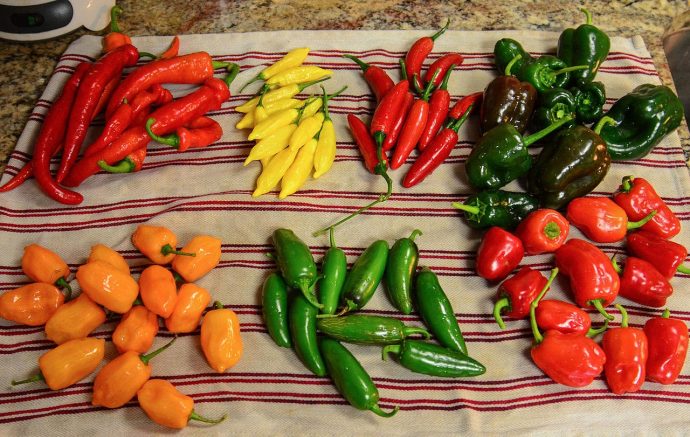Save for ginger, no single ingredient category better embodies the original spirit of the cocktail than hot peppers. It’s right there in the name—cocked-tail, an expression originally referencing equine alertness which became synonymous with the arresting properties of the spicy new beverage. At least, that’s how some have it—your etymology may vary. But whichever origin story you subscribe to, it’s a fact that cocktails were originally created to invigorate the mind and body, and that hot peppers were once a major agent of that effect.
Today, of course, cocktails have a much broader usage. Even the most pedantic tippler isn’t looking at the cocktail menu with the primary intent of having his tail cocked. And while the hot pepper cocktail never really died, it has surely dwindled, maintaining a bastion of relevance among certain tequila and mezcal drinks. Or perhaps it has migrated, serving a crucial role in such spicy, savory tall beverages as the Bloody Mary or Michelada. Whatever the case, in this age of Vodka Red Bulls and Four Loko, it would seem the modern cocktail has little interest in invigoration and, therefore, little need for hot peppers.
And yet, what is dead may never die, as the noted cocktail enthusiasts of the Iron Islands would tell you. Hot peppers are beginning to reappear more and more, in unexpected places and novel ways, offering a far richer and more varied palette of flavors than ever before. It’s enough to make any cocktail drinker’s tail wag, at the very least.
How Hot Pepper Cocktails Cool You Off
On the exact opposite end of the spectrum from the invigorating cocktail, and just in time for the summer heat, is the hot-pepper-as-refresher cocktail.
Of all the benefits of this cocktail renaissance we find ourselves in, the infusion of diverse influences from around the globe may be the most fortunate.
Eating or drinking hot peppers to cool off may seem counterintuitive to those who don’t hail from hot climates, but it’s no coincidence that cultures closest to the equator tend to eat the spiciest foods. Doing so engages a well-known biological process called “gustatory facial sweating,” whereby the temperature in your face rises to match the temperature in the air and activate your body’s air conditioning system—you know, sweat.
It seems mixologists have taken note and are finding new ways to mix hot peppers in with their citrus-based summer drinks, thereby offering a double whammy of refreshment. For example, the simple and reliable Vodka Greyhound, made with vodka and grapefruit, becomes a new beast entirely, the Dalmatian, with some black pepper syrup. Same goes for a gin or vodka lemonade with a pinch of cayenne pepper.
For those of us typically less inclined towards sweeter, more fruit-forward drinks, whether due to our deep-seated masculine insecurities or simply our taste buds, a well-executed hot pepper addition can open up a world of possibilities. Take the Firecracker, a watermelon lemonade- and vodka-based drink at Harlem’s BTH, which includes a generous dash of cayenne and basil to enliven the ingredients and offset any potential cloying sweetness.
Global Flavors
Of all the benefits of this cocktail renaissance we find ourselves in, the infusion of diverse influences from around the globe may be the most fortunate. Until just recently, America’s greatest gift to humanity had remained a largely anglo-focused province. But this is rapidly changing, and it’s now common to find cocktails on the menus of all manner of ethnic restaurants. Of course, it still pays to be a bit skeptical. With every mid-to-high-end restaurant getting in on the gold rush, no one wants to shell out for a mediocre “Wasabi-tini” made by an assistant sushi chef. But with luck you may find some wholly original concoctions, many of them featuring hot peppers.
It’s hard to go wrong experimenting with adding hot peppers to mezcal and tequila.
Thai food, famous for its complex and spicy flavors, offers a great jumping-off point for exotic cocktail exploration. A drink like the Crossfader at Dusek’s Board + Beer in Chicago mixes tequila with lime juice, pineapple syrup, and homemade bitters made from lemongrass, peppercorn and ginger, among other ingredients. Or go right for the jugular with something like a Thai Chili Martini, which is simply a substitution of fresh fruit juice for vermouth—peach or nectarine are recommended—and an addition of muddled Thai chilis to taste.
You can step even further outside the box to check out the fledgling Arab cocktail scene—and by scene we really mean one nomadic pop-up bar, DC’s The Green Zone, where Iraqi barkeep Chris Hassan Francke serves Middle Eastern-inspired drinks like the Fuck ISIS Punch. Aside from the names, the real stars are the homemade syrups and bitters, which Francke coyly presents on the bar with Lebanese labels and simply calls “exotic stuff” on the menu. But its spiciness is clearly evocative of Harissa, the Tunisian hot chili pepper paste beloved by falafel and shawarma eaters the world over.
A Latin Kick
Finally, we’d be remiss not to at least mention the most ubiquitous hot pepper pairers, tequila and mezcal. Pro and amateur bartenders alike have explored all the wondrous ways to bolster the smoky agave flavors with hot peppers. While jalapeño syrups are common and delicious, mezcal also infuses beautifully with jalapeño and, for the truly bold, habanero. Serrano pepper, meanwhile, works nicely for muddling, releasing its heat proportionally to the amount of pressure applied and blending well with all manner of ingredients.
The truth is, it’s hard to go wrong experimenting with adding hot peppers to mezcal and tequila. And with the extra-smokey, high octane mezcals coming out of Mexico these days, there’s really no limit to the spiciness they can handle. At Bagatelle in New York City’s West Village, the Le Green Go garnishes mezcal and elderflower liqueur with a ghost pepper salted rim. That tingly sensation you’re feeling on your lips means it’s working.
Photo: Wikimedia Commons



